University Student Activism
Document Presets
To download, choose the "Save as PDF" option when asked to choose a printer.
Primary Source Set
University Student Activism
In the late 20th century, the United States Supreme Court ruled that students and teachers carry their First Amendment rights to freedom of speech and expression through the doors of their schools—education officials could not claim disturbance of the learning environment. This collection of resources includes newspaper articles, flyers, photographs, and videos to share how college students in North Carolina engaged in protest and activism in the late 1900s and into the early 2000s, both for themselves and for their communities.
Time Period
1950s-2000s
Grade Level
9 – 12
Selected Sources
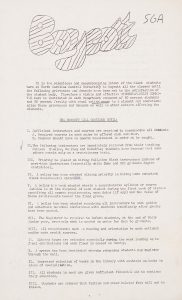
NCCU SGA Boycott Grievances and Demands - Page 1 (1961)
North Carolina Central University, Durham, North Carolina (Durham County), 1961
North Carolina Central University (NCCU) is a historically Black university in Durham, North Carolina, founded in 1909. This flier outlines the demands put forth by the NCCU Student Government Association (SGA) during their organized boycott of classes until their “grievances and demands have been met to the satisfaction of the student body.” They detail their pursuit of a student-faculty committee to implement solutions, through which each population has equal voting power.
Contributed to DigitalNC by North Carolina Central University
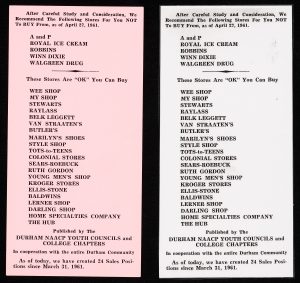
NCCU SGA Business Boycott Flyer (1961)
North Carolina Central University, Durham, North Carolina (Durham County), 1961
Featured in this leaflet are plans of a business boycott organized in the spring of 1961 by the Durham National Association for the Advancement of Colored People Youth Councils and College Chapters (NAACP YCCC), inclusive of students at North Carolina Central University (NCCU).
Contributed to DigitalNC by North Carolina Central University
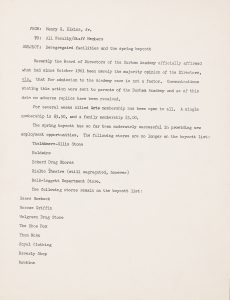
NCCU SGA Boycott Letter (1961)
North Carolina Central University, Durham, North Carolina (Durham County), 1961
The letter further details aspects of the business boycott plan from the perspective of NCCU SGA President Phillip N. Henry. Sent to all faculty and staff members at NCCU, this letter names several recognizable businesses by name that the NAACP YCCC successfully boycotted. This business boycott occurred just a few years after other historic civil rights demonstrations such as the Montgomery Bus Boycott (1955) and the North Carolina A&T University (another historically Black university) sit-in protests at Woolworth’s lunch counter in Greensboro (1960).
Contributed to DigitalNC by North Carolina Central University
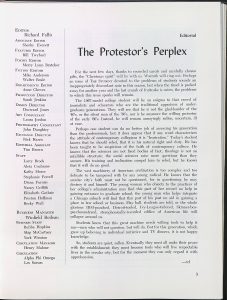
"The Protestor's Perplex" Editorial, The Student (1966)
Wake Forest University, Winston-Salem, North Carolina (Forsyth County), 1966
Published by students at Wake Forest University in Winston-Salem, North Carolina, The Student was founded in 1883 and served as the campus student-produced literary magazine. This issue, published in December 1966, is dedicated to exploring experiences and issues unique to its generation of students.
Topics in the issue range from the prominence of civil rights protests on campuses and across the United States in this era to photo stories documenting student life and joy, and what encompasses being a member of the “Pop Generation.” This excerpt features an editorial from The Student’s editor exploring the conflicting feelings they experience growing up in and around eras of social protest, while also navigating how social institutions and structures (i.e. “the establishment”) often function in ways to prevent any change.
Contributed to DigitalNC by Wake Forest University
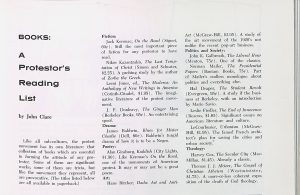
"Books: A Protestor's Reading List" Editorial, The Student (1966)
Wake Forest University, Winston-Salem, North Carolina (Forsyth County), 1966
This excerpt from the 1966-1967 issue of The Student features a compilation of book recommendations that provide insight into the kind of theoretical approaches to protest from which students were learning. This list can provide insight into popular thinking, student interest, and what theoretical support students sought out when engaging in protest on campus and around their communities.
Contributed to DigitalNC by Wake Forest University
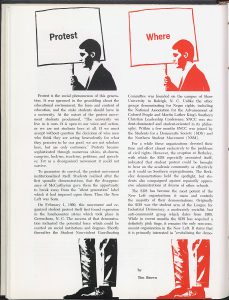
"Protest Where It's At," The Student (1966)
Wake Forest University, Winston-Salem, North Carolina (Forsyth County), 1966
Written by The Student’s editorial assistant, Tim Brown, this article gives one student’s perspective on the trends of protest for their generation, as well as a brief retrospective on protests local to North Carolina and college campuses. This publication was created during a decade of civil rights demonstrations, advancements, and struggles across the country, which simultaneously informed a nationwide conversation around how to achieve progress and what approaches to civil rights advocacy were best. This article concludes in image 53.
Contributed to DigitalNC by Wake Forest University

UNC-Chapel Hill Food Worker Strike Film (1969)
University of North Carolina at Chapel Hill, Chapel Hill, North Carolina (Orange County), 1969
This film features footage from the 1968 Food Worker Strike at the University of North Carolina at Chapel Hill. Coordinated by members of the Black Student Movement (BSM) on campus, this collective action protest advocated for the university’s predominately Black cafeteria workers and their low wages. Over a series of months across 1968-69, tensions grew between strikers/their student supporters and the University, with support of the governor of North Carolina, Robert W. Scott. At times, police units were bused into campus, as depicted in this still from the footage.
Contributed to DigitalNC by University of North Carolina at Chapel Hill
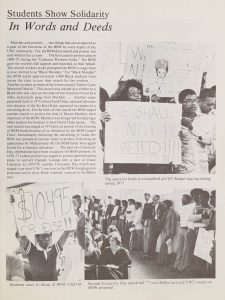
"Students Show Solidarity in Words and Deeds," Ebony Images (1978)
University of North Carolina at Chapel Hill, Chapel Hill, North Carolina (Orange County), 1978
“Students Show Solidarity in Words and Deeds,” is from a 1978 issue of Ebony Images, the yearbook from the Black Student Movement (BSM) at UNC-Chapel Hill. Published alongside a series of photographs, this article details BSM’s involvement in protests on and off campus throughout its early days—this issue celebrates the organization’s 10 year anniversary at UNC-Chapel Hill. Since its founding around 1967, BSM seeks to foster a distinct culture at UNC-Chapel Hill, dedicated to strive for the continued existence of unity among all its members, to voice the concerns and grievances of its members to the University, to offer outlets for expressing Black ideals and culture and to ensure that the Black Student Movement members never lose contact with the Black Community.
Contributed to DigitalNC by University of North Carolina at Chapel Hill
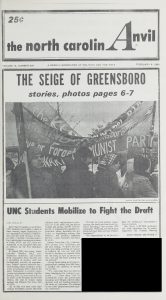
"Students Mobilize to Fight Draft," North Carolina Anvil (1980)
Durham, North Carolina (Durham County, Orange County), 1980
During the Vietnam War, the United States saw a rapid increase in protests against military registration and the draft, which required service for young men via a lottery. This article, published in the politics and arts-focused North Carolina Anvil out of Durham, North Carolina, details this further protest of communities against the draft under President Carter. Predominantly led by college students from Duke University, North Carolina Central University, and North Carolina State University, this organized protest of the military draft sought to protect college students who were in the draft’s targeted population. Interviews from college students in this piece articulate their fears, beliefs, and testimonials in protest of this government action. This article is continued on page 7 under the headline “Students.”
Contributed to DigitalNC by Chapel Hill Historical Society
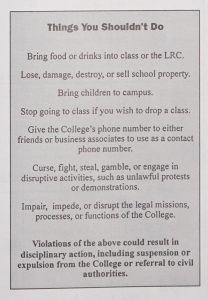
Roanoke-Chowan Community College Student Handbook (2001-02)
Roanoke-Chowan Community College (Hertford County), 2001
Roanoke-Chowan Community College is located in Ahoskie, North Carolina. Each academic year, universities and colleges like Roanoke-Chowan publish student handbooks to provide information and guidance to their students about campus services, school calendars, and community policies. This publication features a section of behaviors students should not engage in, including participation in “protests or demonstration.” About 30 years after the landmark Supreme Court case of Tinker v. Des Moines, this publication stands in potential conflict with the ruling’s protection of students’ right to protest under the First Amendment.
Contributed to DigitalNC by Roanoke-Chowan Community College
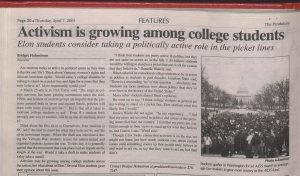
"Activism is growing among college students," The Pendulum (2005)
Elon University, Elon, North Carolina (Alamance County), 2005
This article, from a 2005 issue of Elon University’s student newspaper The Pendulum, discusses how Elon students were experiencing increased motivation to participate in protest and activism on their campus and in their communities. Included alongside the piece is photographic documentation of students protesting in advocacy for AIDS research in Washington, DC.
Contributed to DigitalNC by Elon University
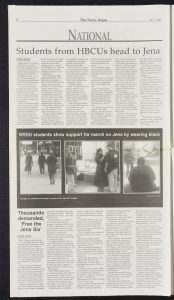
"Students from HBCUs head to Jena," The New Argus (2007)
Winston-Salem State University, Winston-Salem, North Carolina (Forsyth County), 2007
Published by students at Winston-Salem State University (WSSU), The News Argus covers student life and experiences of this historically Black university. This particular section details organization and protest by students at WSSU as they planned to travel to Jena, Louisiana in support of six Black men who were accused of violence against a white student, known at the time as “The Jena Six.” This event stands in a long history of Black men being wrongfully accused of crimes against white people. This article positions WSSU students as vocal participants in support of The Jena Six, and documents their travel to stand alongside protestors in Louisiana.
Contributed to DigitalNC by Winston-Salem State University
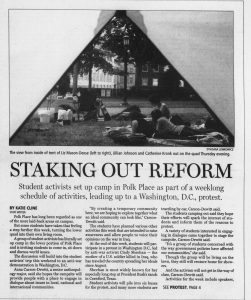
"Staking Out Reform," The Daily Tar Heel (2005)
University of North Carolina at Chapel Hill, Chapel Hill, North Carolina (Orange County), 2005
The Daily Tar Heel is the student-run newspaper at the University of North Carolina at Chapel Hill. This article, from September 2005, provides insight into plans of activism coordinated by a group of students, including a collective takeover of the main quad on campus to create space for open discussion about social issues and how activism can serve as a method towards progress. It also details student plans to conclude the week of activism with travel to Washington, DC to participate in anti-war protests. This article is continued on page 4 under the headline “Protest.”
Contributed to DigitalNC by University of North Carolina at Chapel Hill

"Olympics bring out activism in students," The Daily Tar Heel" (2008)
University of North Carolina, Chapel Hill, North Carolina (Orange County), 2008
Published in UNC-Chapel Hill’s student newspaper, this article details student-led protests and counter protests around the 2008 Olympics. While some student groups took action to show their support of the Olympics, other organizations across campus participated in demonstrations and conversations in protest of the games.
Contributed to DigitalNC by University of North Carolina at Chapel Hill
Background
The second half of the 20th century is known historically for numerous civil rights movements. Over the span of 50 years, this era saw activism around many issues including racial desegregation, reproductive rights, anti-war movements, education, and voting rights. The momentum of these movements encouraged community members of all ages and backgrounds to become vocal about local and national issues in pursuit of equality.
In both North Carolina and across the United States, students played unique and crucial roles in the civil rights movement as participants, organizers, and leaders alike. Just a few years after the landmark case of Brown v. Board of Education (1954), four North Carolina A&T students shifted the national conversation of desegregation to the lunch counter at a local business through the Greensboro Woolworth sit-in demonstrations. Nine years later, the Supreme Court decided in favor of students’ First Amendment right to maintain freedom of speech and demonstration within schools and education environments after nationwide pushback against students’ anti-war armbands. At each of these key moments, students’ rights, voices, and protests served as a point of progress in the civil rights movement.
Throughout the late 20th century and into the 21st century, complexities of civil rights and progress are continually vocalized by students through informal and formal means of communication and protest. This primary source set looks specifically at moments of protest and activism from university students in North Carolina, and the role in which this population engaged with the world around them.
Discussion Questions
How did university students participate in protest and activism in the late 20th and early 21st centuries?
What methods of activism did they use? Why do you think they chose that specific method?
Consider “The Protestor’s Perplex” in The Student from Wake Forest University. What are some of the perceptions of university student activists the author mentions? How are these perceptions impacting students’ views of themselves and their lives?
Often, universities and colleges provide guidelines and policies in an attempt to keep their students safe. Take a moment to imagine yourself in the position of a Roanoke-Chowan Community College student, and you heard about demonstrations similar to those at UNC-Chapel Hill in 2005. How would you feel about their handbook policies discouraging protest participation? Would you still participate? Why or why not?
Imagine you’re a university president in the late 20th century. What plans or policies would you propose in relation to students participating in protests on your campus?
Often, students engaged in activism around issues both on campus, as well as traveling around the country to lend their voices to nation-wide conversations. Information was shared in newspapers, via letters and flyers, and by gathering together in person. What does collective action look like today? How is it similar, and how has it changed?
These materials were compiled by Sarah Costello Dwyer. Updated September 2024.
https://www.digitalnc.org/primary-source-sets/university-student-activism/
This document was prepared for print on August 29, 2025.